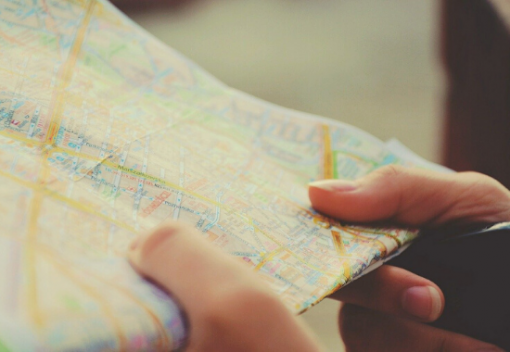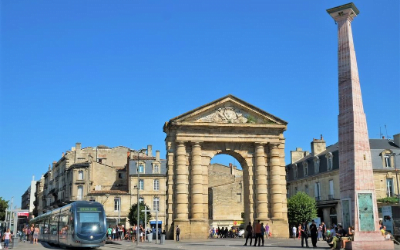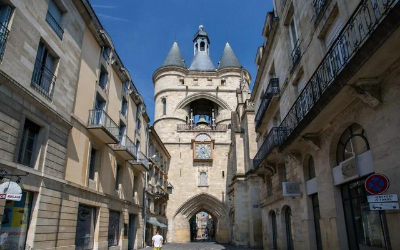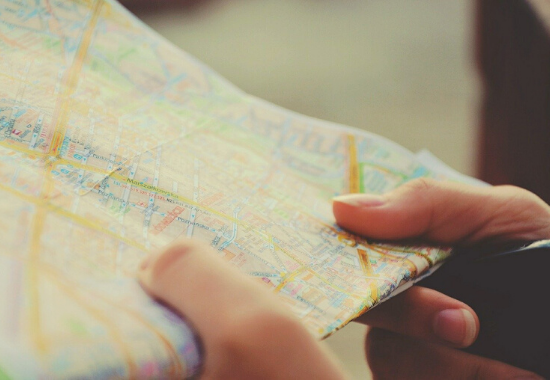
We continue our walking tour in the heart of the city of Bordeaux with 5 new unmissable places…
1. The rue Sainte-Catherine and the Place Saint Projet
The rue Sainte-Catherine is the longest pedestrian shopping street in Europe. It is 1,200 meters long and 10 meters wide, or 3km of shop windows. The origin of its name comes from one of the oldest chapels in Bordeaux: the « Chapelle Sainte-Catherine ». It was located at the current Fnac shop. The well-known pedestrian street has existed since 1984 and links the Place de la Comédie (with the Grand Théâtre) and the Place de la Victoire (with the Porte d’Aquitaine). Since 2015, the rue Sainte-Catherine has hosted the « Promenade Sainte-Catherine », which is equivalent to an open-air shopping center. The rue Sainte-Catherine is very busy and reputed for its shops but also for its two big clearance sales (one in February and one in July) which attract a lot of people.
Walking down the rue Sainte-Catherine, we arrive at the Place Saint Projet: it is an old square in Bordeaux which bears the name of a bishop who died in 674. It is a crossroads of two pedestrian streets: rue Sainte-Catherine and rue Trois Conils. In the past, the square was occupied by a church built in the 14th century and a cemetery (the Saint Projet cross has been moved and is now at the place of the old cemetery).
2. The Place de la Victoire and the Porte d’Aquitaine
By walking down the rue Sainte-Catherine, you arrive at this huge square called Place de la Victoire. Its name was given after the World War I and more precisely on December 3, 1918. It is a must-see square in the city of Bordeaux: it is a place of life and entertainment thanks to its many bars, shows, concerts, markets, demonstrations, and so on. It is a meeting point between four major axes: the cours de l’Argonne, the cours de la Somme (which leads to the boulevards), the cours de la Marne (which leads to Saint-Jean station) and the cours Aristide Briand. It also provides access to the Capucins market via the rue Elie Gintrac and by going up the cours Pasteur, it leads directly to the famous Tour Pey Berland. Since 2005, the square has been decorated with an obelisk and turtles as a tribute to the vineyard (a speciality of the region). But the square is especially recognizable because of its impressive gate: the Porte d’Aquitaine. This name was given in memory of the Duke of Aquitaine. It is a 32,50 meters wide stone gate which was built by André Portier in 1753. It is surmounted by a triangular pediment decorated with sculptures representing sea gods. On the side of the square, you can see the royal coat of arms whereas on the side of the rue Sainte Catherine, you can see fruits and flowers.

3. The Grosse Cloche
We turn towards the quays and make a slight turn around to enter the historic district of Bordeaux…
The Grosse Cloche has long served as a jail with its 10 cm thick doors and huge bolts. It is nested in neighboring buildings, which differentiates it from other Bordeaux gates (such as Dijeaux, Cailhau…). It was also the bell tower of the former town hall (it appears on the Bordeaux coat of arms). The « Grosse Cloche » owes its name to its height. Indeed, it measures 2m high and in diameter. Its weight is estimated at 7750 kg. Under the Grosse Cloche, there is a plaque where a translation of Latin scriptures is written: « I call to arms, I announce the days, I give the hours, I chase the storm (the clouds), I ring the feasts, I cry out for fire ». The bell rings 6 times a year on the occasion of celebrations such as: January 1, May 1, May 8, July 14, August 28, November 11 at 11 a.m., and the 1st Sunday of each month at noon for a quarter of an hour. It has been classified as a historic monument since 1886.

4. The Porte Cailhau
This defensive gate dates from the Middle Ages and was built in 1494. It commemorates the victory of Charles VIII at Fornoue in Italy. Its name’s origin is a mystery, but several assumptions are made: it could come from the French word « caillou » which means « pebble » or it is possible that it comes from a middle-class family who had resided within the neighbourhood. It is one of the most visited monuments in Bordeaux after the Tour Pey Berland. With its height of 35 meters, the richness and the diversity of the ornaments cannot be missed. On its floors, you can discover an exhibition of the materials and tools used to build the gate and more generally the city of Bordeaux. It has been classified as a historic monument since 1883.

5. The passage of the Tour de Gassies
Quite unknown to the citizens of Bordeaux, the passage of the Tour de Gassies is located next to the Place Saint Pierre. It has the particularity of housing the last vestige of the ancient ramparts of « Burdigala », which was the old name given to the city of Bordeaux, dating back to the beginning of the 3rd century. Struck by the barbarian invasions of 276, the city was looted and set on fire. It has then built an enclosure of 740 meters by 480 meters, whose walls were ten meters high and five meters wide. This enclosure had 46 towers and the Tour de Gassies was one of them. Today, in a little courtyard, you can observe this tower’s latest stones. Do not hesitate to explore yourself in the heart of the city! In its numerous streets, Bordeaux has many secrets to reveal…
